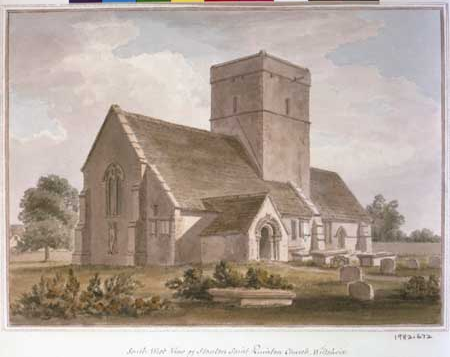Murder in Stanton St Quintin
In this beautiful watercolour by John Buckler, you can see the church at Stanton St Quintin, Wiltshire. Despite its beauty its graveyard holds a tragic tale. The first reference to the murder of George Hartford is made within the London Magazine (volume 33, 1764) describing the murder ‘with such terrible circumstances of ingratitude and cruelty, as are shocking to human nature’. The story even featured in collated works of Aubrey edited by J E Jackson in 1862.
The story starts in 1764. George Hartford, a black sailor, and his fellow sailor companion William Jacques (both of the HMS Stag) had received their pay and headed to Bristol in search of local pubs. Jacques knew the area, especially that of Stanton, as he was the son of Henry Jacques - a rector of Leigh Delamare on Stanton's western border.
Whilst drinking Jacques accused Hartford of stealing his money purse, leading to a bitter fight and both men being persuaded to eventually head home. They started their walk to Stanton and once they arrived at Hullavington they separated; Hartford fell asleep in Stanton Wood and Jacques went to find food within the village. Jacques met up with the sleeping Hartford later on and in a fit of rage bludgeoned him to death, stealing his necktie and own pay.
Local boys saw the murder and Jacques was pursued until he was captured at an ale house in Chippenham, where he confessed to the murder. At his trial at Salisbury on 4th August he confessed to three other murders and a robbery. Jacques continued to state his disbelief over charges of Hartford’s murder since he believed Hartford’s ethnicity would exclude him in court. It didn’t.
Hartford was buried on 26th May under an elm at the churchyard’s western end and is listed within the church burial records between 1720 to 1799. Jacques was punished for his crimes and hanged on Stanton Common on Tuesday 14th August in front of an alleged crowd of 10,000 with people coming from Malmesbury and Chippenham to watch. Jacques’ body remained hanging in chains on the gibbet.
If you view Andrews' and Dury's Map of Wiltshire from 1773 you will see Stanton and its surrounding villages. A fascinating aspect of this map is a small gallows symbol present in Upper Stanton Field. With the murder only occurring nine years before, it may be a link to the very place Jacques was executed and hung in the gibbet. You can access the map on the Wiltshire Community board attached by clicking here.
Written by Tabitha, Digital Volunteer.
John Buckler, (30 November 1770 – 6 December 1851) was a British artist and occasional architect. The Museum houses many of his drawings and paintings of Wiltshire churches. These works provide a record of many architectural details that would have otherwise been lost.


